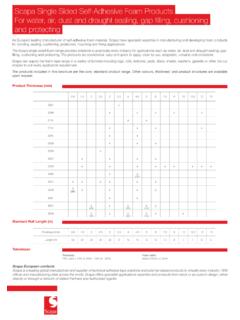Transcription of What does gap analysis mean? A simple framework for …
1 What does gap analysis mean? A simple framework for assessment Jeffrey Parrish and Nigel Dudley In a conservation context, gap analysis is a method to identify biodiversity ( , species, ecosystems and ecological processes) not adequately conserved within a protected area network or through other effective and long-term conservation measures1. It has developed over the past 15 years in response to recognition that protected area systems of all types and in all parts of the world currently do not fully protect biodiversity2.
2 Gap analysis is usually applied to fairly large areas. In an ideal situation it would be applied across the whole of an ecologically defined region (such as an ecoregion), because this allows decisions about conservation to be made with the best available information and on the basis of ecological rather than political boundaries in order to ensure the needs of biodiversity are met. In practice however gap analyses are also frequently carried out for countries or even smaller areas such as states or provinces.
3 Although running potential risks of not capturing critical ecological processes that transcend political borders, national gap analyses are in fact a powerful conservation tools at this scale, particularly if they collaborate with neighbouring countries where appropriate. Gap analyses can vary from quite simple exercises based around a comparison of biodiversity with existing protected area networks to complex studies that require detailed data gathering and analysis , mapping and the use of software decision packages to determine optimal protected area networks.
4 However simple or complicated, cheap or expensive, all gap analyses should follow the following steps: Figure 7: Key steps in a protected area gap analysis Each of these steps is discussed in detail in chapters 6 11; the following section provides a summary of what is required. 9 Identify focal biodiversity and set key targets (see chapter 6): most protected area networks are defined and measured by a set of quantitative targets. These goals can relate in a fairly simple way to area planned for protection or may be specified for the Evaluate and map the occurrence and status of biodiversity Use the information to identify gaps Agree on a strategy and take action Prioritise gaps to be filled Identify focal biodiversity and set key targets Analyse and map the occurrence and status of protected areas conservation of specific targeted species or ecosystems ( focal biodiversity )
5 And descriptive of the desired number and distribution of occurrences or populations. At the simplest level, IUCN The World Conservation Union has suggested that countries set aside at least 10 per cent of their terrestrial area into protected areas and some nations or parts of nations have gone much further in their commitments, , Mongolia (30 per cent) and Sakhalin Republic in the Russian Federation (25 per cent of all forests). More sophisticated targets come from the development of regional or national biodiversity visions or directly from gap analyses.
6 For example, a series of conservation targets have been set for the Forests of the Lower Mekong Ecoregion Complex, including 26 priority areas for conservation and priorities amongst mammals, birds, forests and fish3. 9 Evaluate and map the occurrence and status of critical biodiversity (see chapter 7): Although this step can seem difficult in many countries where surveys of biodiversity are still very incomplete, all countries can proceed in an iterative way with available data and biodiversity surrogate information that can be improved over time as additional data become available.
7 Information is needed on both what ought to be listed and what can be mapped. This stage therefore needs to draw on existing information from all reputable sources, backing this up with new surveys and quality control if time and funds allow. Mapping all species is impossible most countries have only identified a small proportion of their plants and invertebrates for example. Gap analysis therefore often has to rely on data (1) for well-known species (such as mammals, birds, amphibians and fish) (2) for a few key species from other groups that are representative of particular habitats and (3) for ecosystems.
8 Mapping therefore usually draws on a series of coarse or fine filter approaches to build as good a picture as possible of the distribution and status of biodiversity. Coarse and fine filter approaches are complementary rather than alternatives. Coarse filter means use of a unit of biodiversity to capture many other elements, while fine filter refers to species and fine-scale special elements (a category that catches everything that species and habitats may not catch like nesting cliffs, caves azonal habitats like wetlands, etc.)
9 4. Studies will therefore usually involve consolidating diverse data sets (including relevant international data sets such as the Red List) using geographic information systems (GIS); and standardising habitat and land-use classification systems for the area being studied. Predictive models based on habitat affinities for key indicator species may be useful in some cases although they have clear limitations in terms of accuracy5. 9 Analyse and map the occurrence and status of protected areas (see chapter 8): Basic data on protected areas are usually available at national level although precise spatial information is frequently lacking and information on protected areas in other governance systems ( private protected areas or indigenous areas).
10 Information about status of protected areas is generally less available, including issues relating to management objectives, governance and management effectiveness, although studies and data on these are starting to emerge. This information however is important for inclusion in a gap analysis however, even if it only exists in approximate form, as protected areas may exist on paper, but their governance, management, or management objectives may mean that no biodiversity conservation is afforded. Coupling maps of protected areas with even cursory knowledge about their management status is central to any gap analysis .







